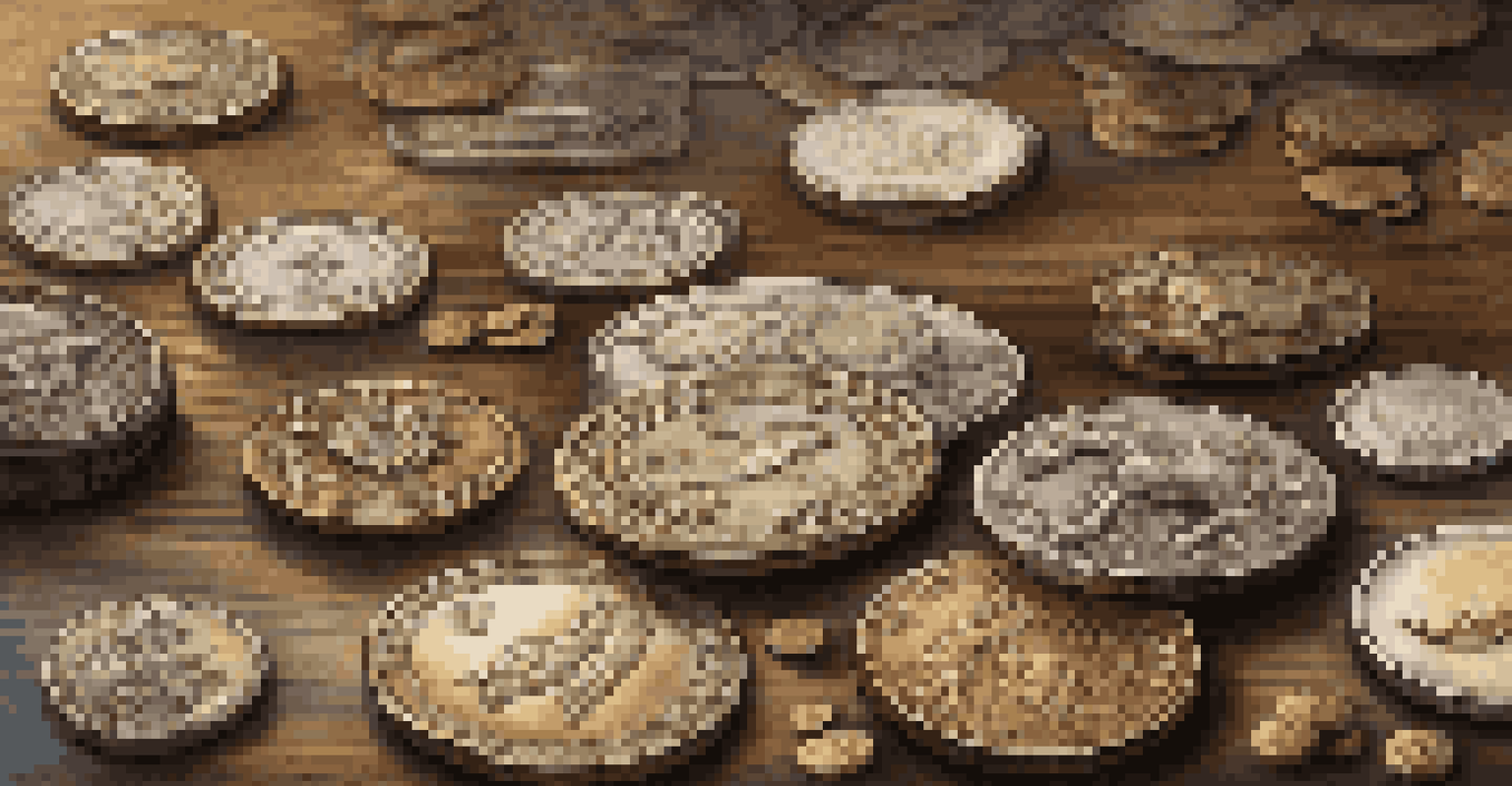The Evolution of Currency: From Barter to Modern Coins

The Origins of Barter: A Simplistic Exchange System
Before money existed, people relied on barter, which is the direct exchange of goods and services. Imagine trading a basket of apples for a pair of shoes; that’s the essence of barter. While this system worked on a small scale, it often led to complications, such as the need for a 'double coincidence of wants'—both parties needing what the other offered.
Money is a terrible master but an excellent servant.
Bartering required a mutual agreement on the value of different items, which could be subjective and confusing. For instance, how many apples equal a pair of shoes? This ambiguity often made transactions cumbersome and inefficient. As communities grew, the limitations of barter became increasingly apparent.
To resolve these issues, the idea of a standardized medium of exchange began to take shape, paving the way for the evolution of currency. People started to use commodities, like salt or cattle, that had intrinsic value and were widely accepted, setting the stage for more formalized currency systems.
The Rise of Commodity Money: Value Beyond Goods
As societies advanced, so did their understanding of value, leading to the use of commodity money. This type of currency was based on items with intrinsic value, such as gold, silver, or even shells. For example, gold was prized not just for its beauty but also for its rarity and durability, making it an ideal medium for trade.

Commodity money simplified transactions by providing a universally accepted measure of value. Imagine trading a handful of silver coins instead of counting out bushels of grain each time. This shift made commerce more efficient and allowed for the growth of markets and trade routes.
Barter: The Roots of Trade
Before money, barter was the primary exchange system, relying on direct trade of goods and services.
However, while commodity money had its advantages, it wasn’t without flaws. Issues like storage, transportation, and the risk of theft presented challenges, prompting societies to seek an even more efficient currency solution.
Metal Coins: The Birth of Standardized Currency
The introduction of metal coins marked a significant milestone in the evolution of currency. Around 600 BCE, the Lydians in modern-day Turkey minted the first coins, which were made from electrum—a naturally occurring alloy of gold and silver. These coins had specific weights and stamped designs, establishing a standard of value.
The first rule is not to lose. The second rule is not to forget the first rule.
This innovation made transactions quicker and more reliable. Instead of carrying bulky commodities, people could simply carry coins, which were easier to count and trade. It also allowed for the creation of complex economies where trade could flourish without the limitations of barter.
As various cultures adopted coinage, they began to inscribe their coins with symbols and images, further solidifying their legitimacy and value. Coins not only facilitated trade but also became a means of expressing political power and cultural identity.
Paper Money: A Revolutionary Step Forward
The advent of paper money in the 7th century in China signified a revolutionary leap in currency evolution. Initially, merchants used promissory notes that represented a promise to pay, which eventually led to the creation of government-issued paper currency. This shift allowed for easier transactions and reduced the physical weight of carrying coins.
Imagine trying to conduct a large trade with just coins; it would be cumbersome and impractical. Paper money simplified this process, enabling people to engage in larger transactions without the hassle. It also paved the way for the concept of banks, which could issue and manage currency more effectively.
The Shift to Commodity Money
As societies evolved, commodity money emerged, providing a more efficient and universally accepted medium of exchange.
However, the reliance on paper money introduced new challenges, such as counterfeiting and the need for trust in the issuing authority. These issues prompted the development of security features and regulations, ensuring that paper currency retained its value.
The Gold Standard: Linking Currency to Precious Metals
In the 19th century, many countries adopted the gold standard, linking their currency directly to gold reserves. This system provided a sense of stability and trust, as people could theoretically exchange their paper money for a specific amount of gold. It created a standardized value that was understood globally.
The gold standard encouraged international trade and investment, as countries had a common basis for valuing currency. It also helped prevent inflation since the amount of currency in circulation was limited by gold reserves. Imagine knowing that every dollar you held could be exchanged for a fixed amount of gold; it instilled confidence in the economy.
However, the rigidity of the gold standard also had its downsides. Economic fluctuations and the demands of wartime spending often led to debates about its sustainability, eventually leading to its abandonment in the 20th century.
Fiat Currency: Trust in Government Over Gold
Following the decline of the gold standard, fiat currency emerged as a new norm. Unlike previous forms of currency, fiat money has no intrinsic value but is backed by the trust and confidence in the government that issues it. In simpler terms, a dollar bill only holds value because we collectively agree it does.
Fiat currency allows for greater flexibility in monetary policy, enabling governments to adjust the money supply to meet economic needs. For instance, during a recession, a government can print more money to stimulate the economy. This adaptability can be crucial for managing economic challenges.
Fiat Currency and Trust
Fiat currency, backed by government trust rather than intrinsic value, allows for flexible monetary policy but raises concerns about inflation.
However, the reliance on fiat currency also raises concerns about inflation and the potential for devaluation. The key lies in maintaining public trust; if people lose faith in their currency, its value can plummet, leading to economic instability.
Digital Currency: The Future of Money
As technology advances, digital currencies have started to reshape the landscape of money. From online banking to cryptocurrencies like Bitcoin, the way we think about and use currency is evolving rapidly. Digital currencies offer the convenience of instant transactions and can transcend geographical boundaries.
Imagine sending money to a friend on the other side of the world in a matter of seconds—this is now a reality with digital currencies. They also provide a level of anonymity and security that traditional banking systems struggle to offer. However, the volatility of cryptocurrencies raises questions about their long-term viability.

While digital currency presents exciting opportunities, it also brings challenges, such as regulatory concerns and the potential for cybercrime. As we navigate this new frontier, the evolution of currency continues, reflecting our ever-changing relationship with money.